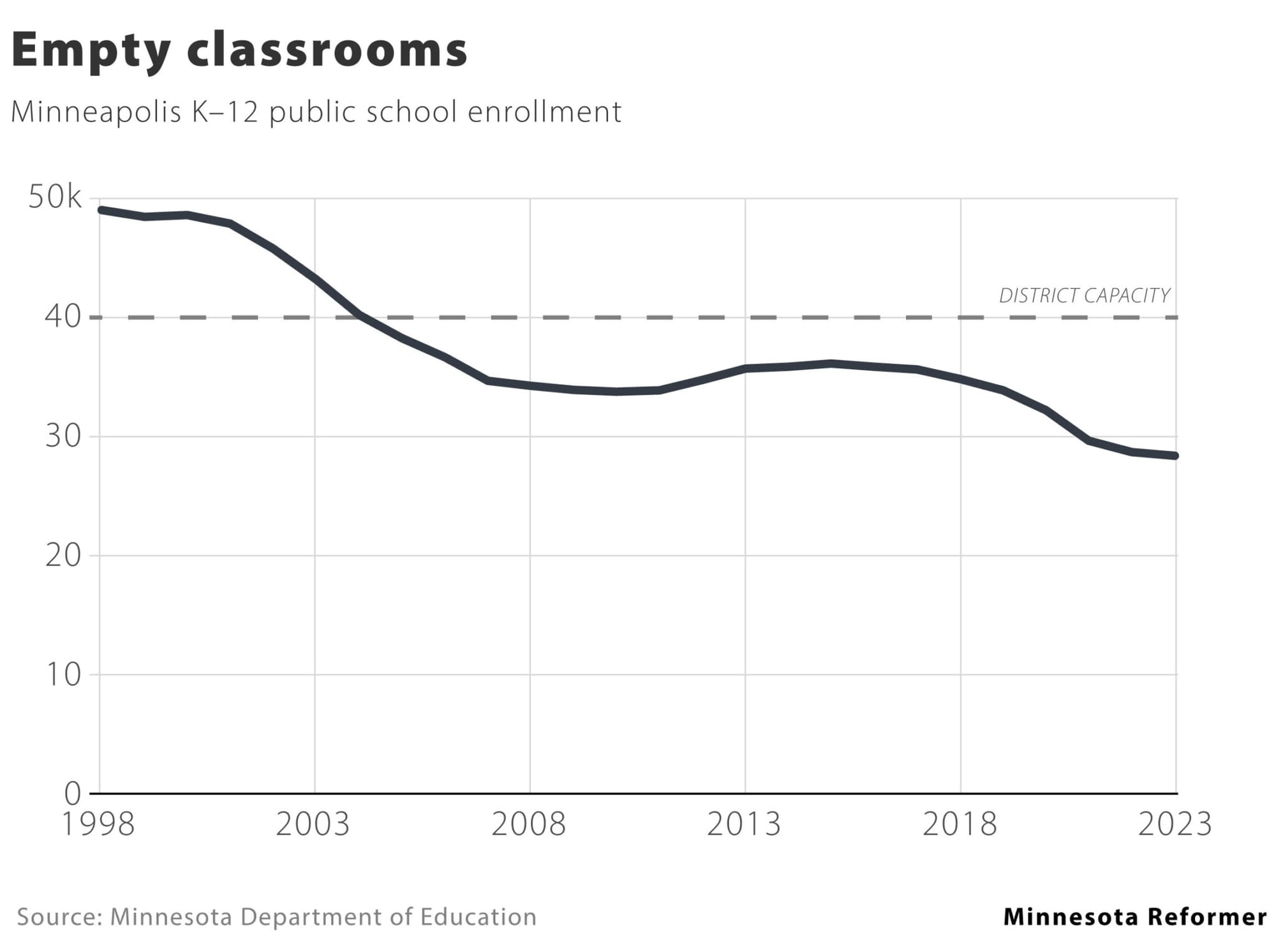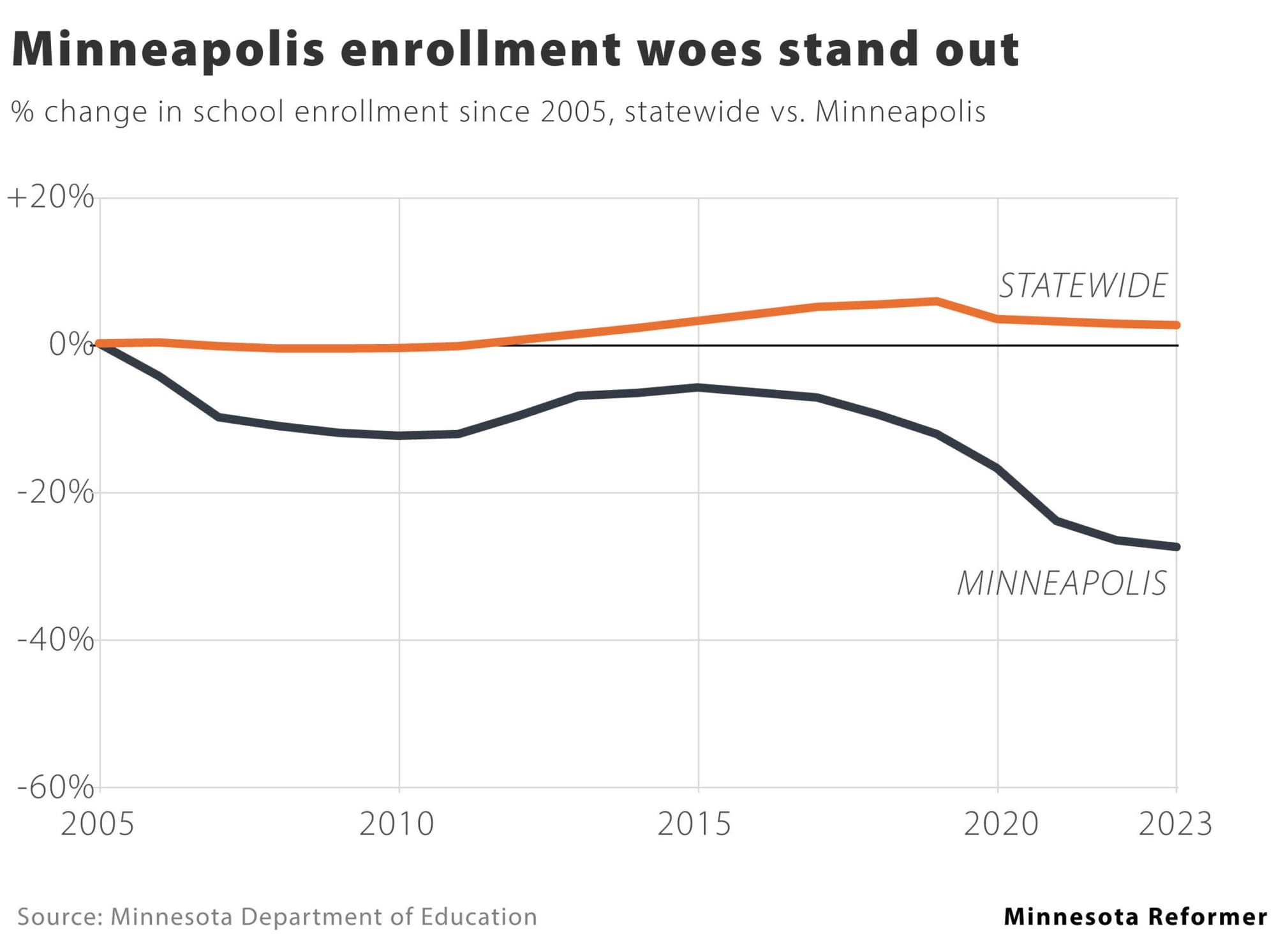By Christopher Ingraham, Minnesota Reformer
Minneapolis school board members met on Tuesday to discuss how to close a projected $110 million funding gap. The shortfall, which puts the district on the brink of insolvency and state intervention, is driven largely by a long-term decline in enrollment stretching back at least a quarter century.
Official state figures from the fall of 2023 show that K-12 enrollment in Minneapolis public schools stood at around 28,000 students, a drop of 16% since before the pandemic and a staggering 43% since the dawn of the 21st century.

The general trend shows a decade of decline from roughly 1998 to 2008, followed by a decade of relative stability. But enrollment numbers began edging downward again starting in the mid-2010s.
Public school advocates often point to significant events that drove down enrollment. The first was a wave of laws intended to reform public education like the charter school movement, which was birthed here, as well as open enrollment that allowed students to attend school in any district. Some argue these were intended to undermine public schools, especially in cities like Minneapolis.
The second event was MPS’ recent redistricting plan, which sought to integrate schools by centralizing magnet schools, shrinking high schools in south Minneapolis and growing them in north Minneapolis. The plan faced opposition from many parents and took effect during the 2021-22 school year, when many families were already exhausted with pandemic school closures; enrollment suffered when many sent their children to private or suburban schools.
Public school advocates and the teachers union also argue the district is exaggerating its funding shortfall as a negotiating tactic with the union, which struck in 2022 and has been working without a contract for several months.
Regardless, MPS is set up to serve about 40,000 students, according to the district. But it hasn’t enrolled that many in two decades.
“Despite decreases in student enrollment over the past 10 years, proportionate changes in the operational structure of our district have not been made,” according to a budget document presented to school board members on March 5. “Recent historic new state education funding has helped immensely, but it’s not enough to both make up for decades of underfunding and to cover increased costs of running MPS.”
Part of the decline in recent years is strictly demographic. While stabilizing somewhat in the most recent data, Minneapolis’ overall population has fallen since the start of the pandemic.
“The number of students that we would need to be at full capacity don’t even exist in the city, because we have declining demographics,” Ibrahima Diop, MPS’ chief of finance, recently told MPR News.
But demographics are only a part of the issue. Since 1998, for instance, Minneapolis’ population has increased by roughly 20%. But Minneapolis Public Schools’ enrollment has fallen by more than 40% over the same period.

Charter schools and open enrollment are responsible for about one-fifth of Minneapolis’s recent enrollment losses, according to the auditor’s report.
Overall, charters and open enrollment “have siphoned roughly 19,000 students, over 35% of the city’s entire student body, out of Minneapolis’ public schools,” the auditor estimates. The district’s recent redistricting plan may have resulted in a loss of several thousand additional students, according to the audit report.
Similar issues are in play across the state, and in many other large school districts in the U.S. But within Minnesota, Minneapolis schools stand out for the depth of the problem. Statewide, for instance, overall K-12 enrollment has mostly held steady, now standing about 2% higher than it was in 2005. But Minneapolis schools lost more than 35% of their students over the same period.

Minnesota Reformer is part of States Newsroom, a nonprofit news network supported by grants and a coalition of donors as a 501c(3) public charity. Minnesota Reformer maintains editorial independence. Contact Editor J. Patrick Coolican for questions: info@minnesotareformer.com. Follow Minnesota Reformer on Facebook and Twitter.



